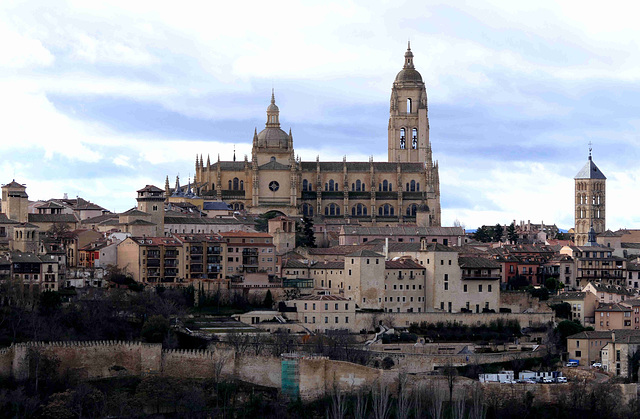Segovia - La Vera Cruz
Segovia - La Vera Cruz
Segovia - San Martín
Segovia - San Lorenzo
Toledo - El Cristo de la Luz
Toledo - El Cristo de la Luz
Toledo - Catedral de Toledo
Toledo - San Sebastián
Madrid - San Francisco el Grande
Madrid - San Francisco el Grande
Guadalajara - Iglesia de los Remedios
Sigüenza - Catedral de Santa María
Carabias - Iglesia de San Salvador
Palazuelos - Ermita de la Virgen de la Soledad
Sigüenza - Catedral de Santa María
Cuenca - Catedral de Santa María y San Julián
Daroca - Santo Domingo
Daroca - San Miguel
Teruel - Torre de San Salvador
Teruel - Catedral de Teruel
Mora de Rubielos - Santa María
Valencia - Iglesia de los Santos Juanes
Almería - Catedral de Almería
Segovia - La Santísima Trinidad
Avila - Ermita de Sonsoles
Ávila - Catedral de Cristo Salvador
Ávila - Ermita de San Segundo del Río Adaja
Ávila - San Andrés
Ávila - Santo Tomé el Viejo
Ávila - Basílica de San Vicente
Salamanca - Catedral Nueva
Toro - San Lorenzo el Real
Toro - Colegiata de Santa María la Mayor
Zamora - Catedral de Zamora
Zamora - Catedral de Zamora
Zamora - Catedral de Zamora
Zamora - Santa María Magdalena
Zamora - San Cipriano
El Campillo - San Pedro de la Nave
Benavente - San Juan del Mercado
Benavente - Santa María del Azogue
Valladolid - Iglesia de San Pablo
Valladolid - Santa María La Antigua
Valladolid - Santa María La Antigua
Peñafiel - Convento de San Pablo
Location
Lat, Lng:
You can copy the above to your favourite mapping app.
Address: unknown
You can copy the above to your favourite mapping app.
Address: unknown
See also...
Keywords
Authorizations, license
-
Visible by: Everyone -
All rights reserved
-
88 visits
Segovia - Catedral de Segovia


A Celtic castle existed here, from which resistance against the Romans originated. The city was nevertheless taken. Afterward, it began to be built as a Roman city and became an important Roman military base.
In the second half of the 5th century, Segovia became part of the Visigoth Empire. From the 8th to the 11th centuries, Segovia was under Moorish possession. In 1085 Alfonso VI conquered the city. From the 13th to the 15th century it was a royal residence.
The predecessor of the Catedral de Segovia (aka "Santa Iglesia Catedral de Nuestra Señora de la Asunción y de San Frutos de Segovia" was a church that began around 1140 when Segovia was repopulated under Alfonso VII. This church was destroyed during a popular uprising in Castile in 1520. In 1525 the cathedral chapter decided to build a new building. The foundation stone was laid in 1525. In 1558 the building was completed up to the transept and was consecrated as a cathedral. It was erected in a late Gothic style, outdated elsewhere in Europe.
In 1614 the large spire was destroyed by lightning. It was made of mahogany imported from America and covered with fire-gilded lead. The cathedral ceilings were also damaged by the fire. During a restoration around 1620, the tower was given its current shape, reduced by 12 m in height.
The cathedral was finally consecrated in 1768. It is 105 m long and 50 m wide. The central nave is 33 m high. The tower measures 88 m.
In the second half of the 5th century, Segovia became part of the Visigoth Empire. From the 8th to the 11th centuries, Segovia was under Moorish possession. In 1085 Alfonso VI conquered the city. From the 13th to the 15th century it was a royal residence.
The predecessor of the Catedral de Segovia (aka "Santa Iglesia Catedral de Nuestra Señora de la Asunción y de San Frutos de Segovia" was a church that began around 1140 when Segovia was repopulated under Alfonso VII. This church was destroyed during a popular uprising in Castile in 1520. In 1525 the cathedral chapter decided to build a new building. The foundation stone was laid in 1525. In 1558 the building was completed up to the transept and was consecrated as a cathedral. It was erected in a late Gothic style, outdated elsewhere in Europe.
In 1614 the large spire was destroyed by lightning. It was made of mahogany imported from America and covered with fire-gilded lead. The cathedral ceilings were also damaged by the fire. During a restoration around 1620, the tower was given its current shape, reduced by 12 m in height.
The cathedral was finally consecrated in 1768. It is 105 m long and 50 m wide. The central nave is 33 m high. The tower measures 88 m.
kiiti, buonacoppi, Paolo Tanino, appo-fam and 2 other people have particularly liked this photo
- Keyboard shortcuts:
Jump to top
RSS feed- Latest comments - Subscribe to the comment feeds of this photo
- ipernity © 2007-2025
- Help & Contact
|
Club news
|
About ipernity
|
History |
ipernity Club & Prices |
Guide of good conduct
Donate | Group guidelines | Privacy policy | Terms of use | Statutes | In memoria -
Facebook
Twitter

Sign-in to write a comment.